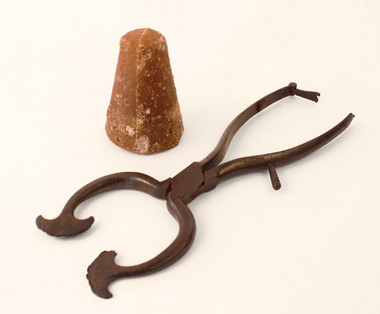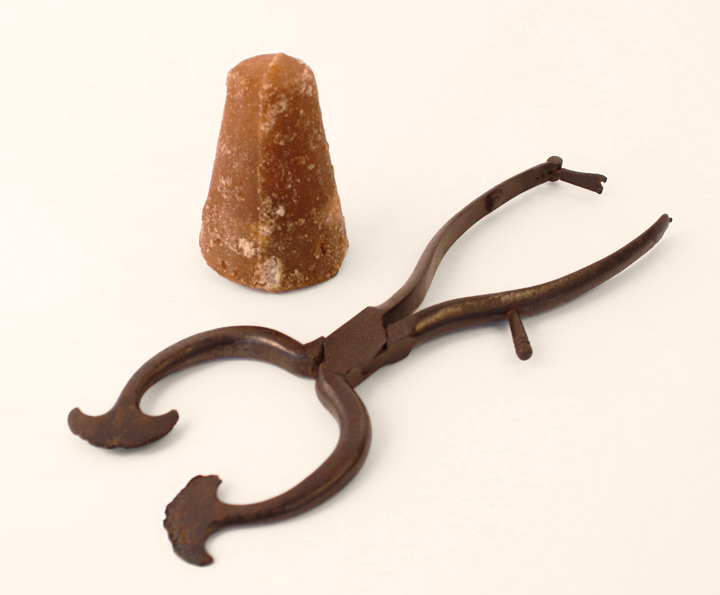Sugar Scissors & Sugar Cone, Medieval-Victorian
The photograph shows a pair of original Victorian iron sugar scissors, with a block of solid sugar cone purchased from a historical re-enactment supplier.
Today we use sugar in cakes and biscuits and to sweeten food and drink. However, when sugar was first brought to Europe in the 12th Century it was used as flavouring for food in the same way as spices were used and also as medicine (especially for colds). Grown in the Caribbean, sugar and the indentured servants and slave trade are closely associated. Visit http://caribbean-guide.info/past.and.present/history/sugar.slavery/ for information.
Sugar was expensive as it was taxed heavily until the 19th Century. Poorer people in Europe used honey instead of sugar as this was cheaper. We can now buy sugar in a variety of forms, as lumps, granules or powder. However, sugar used to be sold in tall, conical loaves that were made by pouring liquid sugar into a mold. Pieces of sugar would be snipped off the loaf using scissors and then pounded or ground, depending on what the sugar was going to be used for. The sugar was cut with special iron sugar-cutters like the ones above. As you can see they are shaped something like very large heavy pliers with sharp blades attached to the cutting sides, these cutters had to be strong and tough. It is easy to imagine that snipping off the hard sugar was difficult and that little bits flew everywhere!
From Medieval times to the 19th Century, refined sugar was sold in solid form, often in cones, blocks or loaves. This cone is probably a bit smaller and less refined than high quality medieval sugar. It is made from sugar cane that has been hand cut and crushed mechanically to extract the pure sugar cane juice. The juice is then heated to reduce its water content, and the resulting thick syrup is poured into cone-shaped molds to dry. The sugar is minimally processed and unadulterated, having no added molasses or chemicals, and contains all the minerals and vitamins inherently present in sugarcane juice.

Tongs length:24cm

Tongs length:24cm

The photograph shows a pair of original Victorian iron sugar scissors, with a block of solid sugar cone purchased from a historical re-enactment supplier.
Today we use sugar in cakes and biscuits and to sweeten food and drink. However, when sugar was first brought to Europe in the 12th Century it was used as flavouring for food in the same way as spices were used and also as medicine (especially for colds). Grown in the Caribbean, sugar and the indentured servants and slave trade are closely associated. Visit http://caribbean-guide.info/past.and.present/history/sugar.slavery/ for information.
Sugar was expensive as it was taxed heavily until the 19th Century. Poorer people in Europe used honey instead of sugar as this was cheaper. We can now buy sugar in a variety of forms, as lumps, granules or powder. However, sugar used to be sold in tall, conical loaves that were made by pouring liquid sugar into a mold. Pieces of sugar would be snipped off the loaf using scissors and then pounded or ground, depending on what the sugar was going to be used for. The sugar was cut with special iron sugar-cutters like the ones above. As you can see they are shaped something like very large heavy pliers with sharp blades attached to the cutting sides, these cutters had to be strong and tough. It is easy to imagine that snipping off the hard sugar was difficult and that little bits flew everywhere!
From Medieval times to the 19th Century, refined sugar was sold in solid form, often in cones, blocks or loaves. This cone is probably a bit smaller and less refined than high quality medieval sugar. It is made from sugar cane that has been hand cut and crushed mechanically to extract the pure sugar cane juice. The juice is then heated to reduce its water content, and the resulting thick syrup is poured into cone-shaped molds to dry. The sugar is minimally processed and unadulterated, having no added molasses or chemicals, and contains all the minerals and vitamins inherently present in sugarcane juice.




















